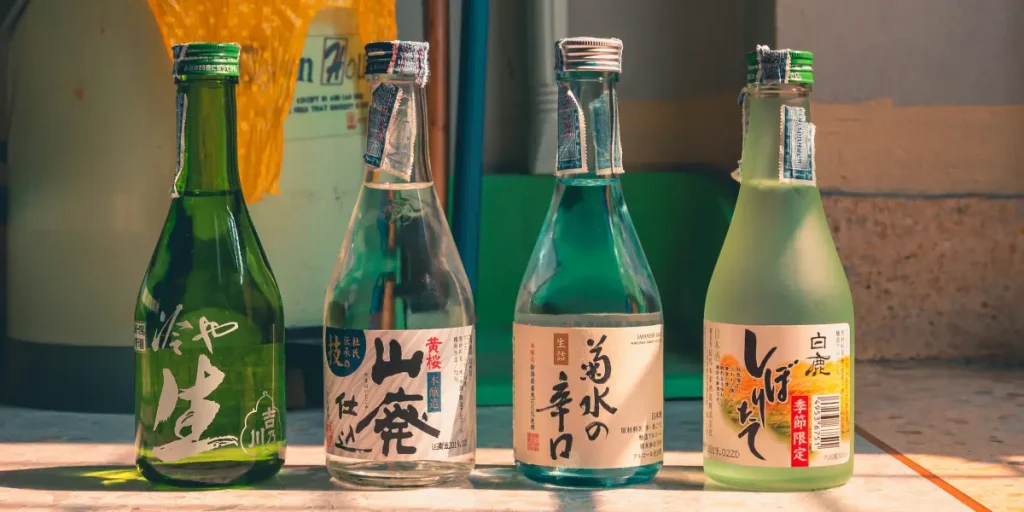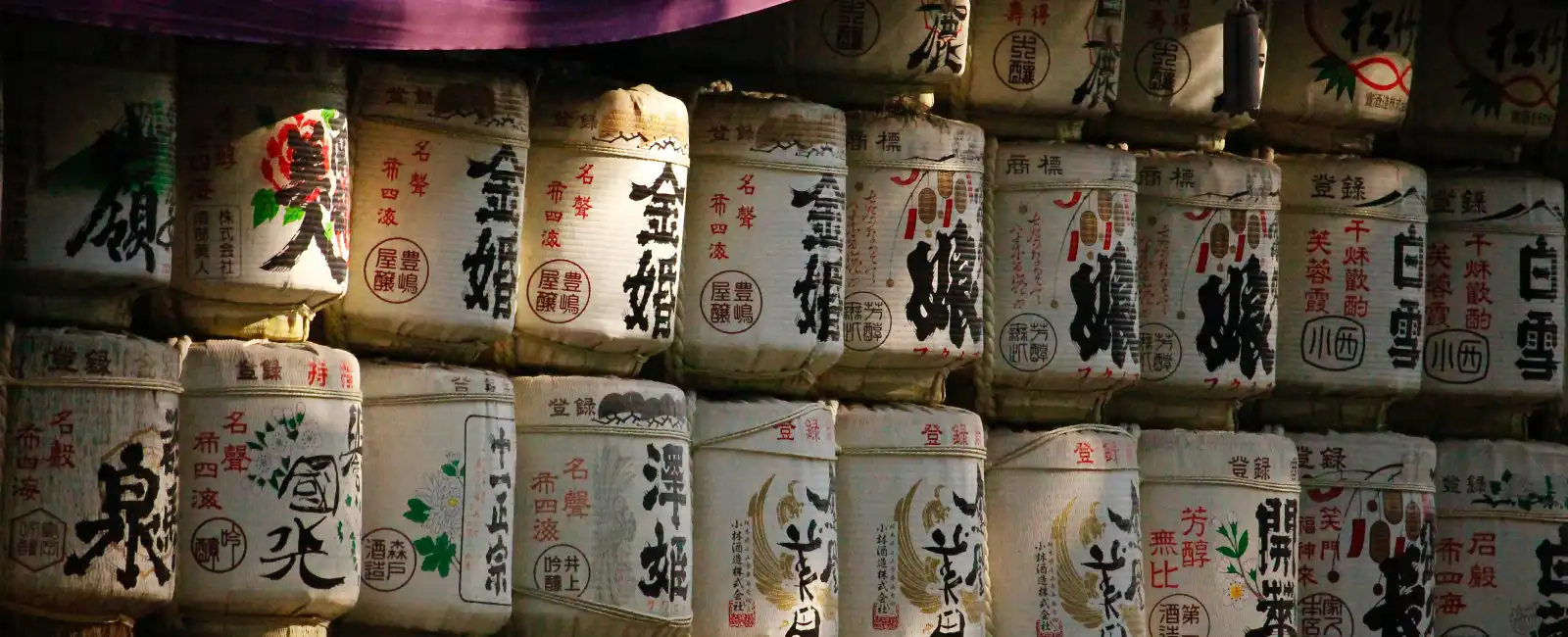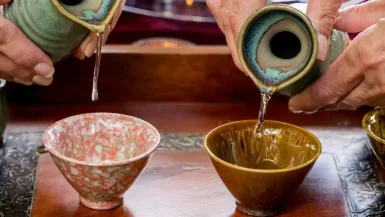Introduction
Japanese sake, a traditional alcoholic beverage, is renowned worldwide. Its unique flavor and cultural significance make it a must-try for visitors. Japanese Sake and Brewery Tours provide an immersive experience, allowing visitors to witness the intricate process of sake production. This blog post aims to explore the world of Japanese sake and brewery tours, offering insights into the history, production process, types of sake, and the best brewery tours in Japan.
The History of Japanese Sake
Sake has a rich history that dates back over a thousand years. Experts believe it originated during the Nara period (710-794 AD). Initially, people produced sake as a religious activity in Shinto shrines and Buddhist temples. Over time, it became a popular drink among the general populace. The Edo period (1603-1868) saw significant advancements in sake brewing techniques, many of which are still in use today. During this era, sake breweries began to proliferate across Japan, each developing its unique flavor profiles. The Meiji period (1868-1912) introduced modern brewing methods, incorporating scientific principles to enhance quality and consistency. Today, sake continues to evolve, with a resurgence in artisanal production and a growing global appreciation for this iconic Japanese beverage. Whether enjoyed warm or chilled, sake remains a symbol of Japan’s deep cultural heritage.
The Art of Sake Production
Rice: The Heart of Sake
The primary ingredient in sake is rice, but not just any rice. Sake rice, or ‘sakamai,’ is specially cultivated for brewing. It has larger grains with a higher starch content. The polishing process, which removes the outer layers of the rice grain, is crucial. The more the rice is polished, the higher the grade of sake. This polishing exposes the starchy core of the grain, which is essential for producing a clean and refined flavor. After polishing the rice, brewers wash and soak it to prepare for steaming, a crucial step in the brewing process. They steam the rice and then cool it before mixing it with koji mold, yeast, and water to start fermentation. Over several weeks, this fermentation process converts the rice’s starches into sugars and then alcohol, developing the rich, complex flavors that define sake.
Water: The Lifeblood of Sake
Water is another essential component. It is used in almost every step of the sake brewing process. The mineral content of the water can significantly affect the flavor of the final product. Historically, sake breweries were established near sources of pure, soft water. Water high in iron or manganese can spoil the taste, so brewers carefully select their water sources. Some regions in Japan are renowned for their water quality, which contributes to the distinct characteristics of the sake produced there. Water is not only important for brewing but also for cleaning the equipment, ensuring that no impurities affect the fermentation. In fact, the importance of water in sake brewing is so profound that it’s often said that “good water makes good sake.
Koji: The Magic Mold
Koji mold, or Aspergillus oryzae, plays a vital role in converting the starches in rice into fermentable sugars. In fact, this process, known as saccharification, is essential for sake production. To begin with, koji is carefully cultivated in a warm, humid environment, which requires expertise and precision. As the process continues, the mold’s enzymes break down complex carbohydrates, making the sugars available for yeast fermentation. Furthermore, the quality of koji directly impacts the flavor profile of the final sake, making it a crucial element in the brewing process. Therefore, experienced brewers monitor the koji closely, adjusting conditions to ensure optimal growth and enzyme activity.
Koji also enhances flavor through fermentation in other traditional Japanese foods like miso and soy sauce. Brewers pass down the art of cultivating koji through generations, preserving this time-honored tradition.Its significance extends beyond just brewing, as koji has also been studied for its potential health benefits. Understanding koji is key to appreciating the craftsmanship behind traditional Japanese fermentation techniques.
Yeast: The Fermentation Agent
Yeast is responsible for converting the sugars into alcohol and carbon dioxide. Different strains of yeast can produce varying flavors and aromas. The choice of yeast strain is a crucial decision for sake brewers. Certain yeast strains may enhance fruity notes, while others might bring out floral or earthy characteristics in the final product. The fermentation temperature also plays a significant role in how the yeast performs, further influencing the sake’s profile. A carefully selected yeast strain, paired with the right brewing conditions, can elevate a sake’s quality and uniqueness. Some sake brewers even cultivate their proprietary yeast strains to create a signature taste. Understanding the intricacies of yeast behavior is essential for producing sake that stands out in the market.
Types of Sake
Junmai: Pure Rice Sake
To begin with, Junmai sake is made with only rice, water, koji, and yeast. As a result, it has a robust flavor profile and is often enjoyed warm. Moreover, the absence of added alcohol allows the natural flavors of the ingredients to shine. In addition, Junmai sake tends to have a fuller body and a richer taste compared to other types of sake. Brewers carefully control the fermentation process for Junmai sake to bring out the deep umami flavors characteristic of this traditional Japanese beverage. Consequently, people often pair Junmai sake with hearty dishes like grilled meats or savory stews, which enhances the dining experience. Furthermore, connoisseurs appreciate Junmai sake for its complexity and the subtle variations in taste depending on the rice variety and region of production.
Ultimately, the purity of Junmai sake makes it a favorite among those who seek an authentic sake experience, connecting them to the rich cultural heritage of Japan.
Honjozo: Light and Smooth
Honjozo sake has a small amount of distilled alcohol added during the brewing process. This addition helps to extract more flavor from the rice. Honjozo sake is typically lighter and smoother than Junmai sake. The added alcohol also enhances the aroma, making it more fragrant and appealing. People often enjoy this type of sake chilled or at room temperature, which highlights its delicate balance of flavors. Honjozo sake pairs well with a variety of dishes, including sushi, grilled meats, and light appetizers. Many sake enthusiasts appreciate its versatility and refined taste, making it a popular choice for both casual drinking and special occasions. While it may have a slightly lower rice polishing ratio compared to some premium sakes, Honjozo remains a favorite for those seeking a harmonious and accessible sake experience.
Ginjo: Aromatic and Delicate
To create Ginjo sake, brewers polish the rice to at least 60% of its original size. The fermentation process occurs at lower temperatures, resulting in a fragrant and delicate sake. Ginjo sake is best enjoyed chilled. Its refined flavor profile often includes subtle fruity or floral notes, making it a favorite among sake connoisseurs. The meticulous brewing process requires skilled craftsmanship, ensuring a smooth, clean taste with a light, elegant finish. Ginjo sake pairs wonderfully with lightly seasoned dishes, such as sashimi or grilled fish, allowing the sake’s delicate flavors to shine. For the best experience, serve it in a wine glass to fully appreciate its aroma and complexity.
Daiginjo: Premium and Refined
Daiginjo sake is the pinnacle of sake brewing. The rice is polished to at least 50% of its original size. The meticulous brewing process produces a refined and complex flavor profile. Daiginjo sake is often reserved for special occasions.
The Sake Brewing Process
Rice Polishing
The first step in sake production is rice polishing. The outer layers of the rice grain are removed, leaving behind the starchy core. The degree of polishing, or “seimaibuai,” significantly impacts the flavor and quality of the sake.
Washing and Soaking
After polishing, the process involves washing the rice to remove any residual rice bran. Next, the rice soaks in water to reach the desired moisture content. The soaking time differs depending on the type of sake being produced.
Steaming
Steaming the soaked rice gelatinizes the starches, making them more accessible for the koji mold.Steaming is a critical step that affects the texture and flavor of the final product.
Koji Making
Koji mold inoculates steamed rice, which then ferments in a warm, humid environment. This process takes about 48 hours and requires constant monitoring to ensure optimal conditions.
Yeast Starter
The brewer prepares a yeast starter, or “shubo,” by mixing steamed rice, water, koji, and yeast. This mixture ferments for about two weeks, creating a concentrated batch of yeast cells.
Main Fermentation
The main fermentation, or “moromi,” involves mixing the yeast starter with more steamed rice, water, and koji. This process takes about 20 to 30 days. The brewers carefully monitor and stir the mixture to ensure even fermentation.
Pressing
After fermentation completes, the brewers press the mixture to separate the liquid from the solids. They then filter the liquid, now sake, to remove any remaining impurities.
Pasteurization and Bottling
The brewers pasteurize the sake to kill any remaining bacteria and stabilize the flavor. Afterward, they age it for a few months before bottling. Some types of sake undergo a second pasteurization before shipping.

Exploring Brewery Tours in Japan
Kyoto: Fushimi District
Kyoto’s Fushimi district is also famous for its sake breweries. The area benefits from high-quality water, making it an ideal location for sake production. Gekkeikan Okura Sake Museum offers an excellent tour, providing insights into the history and production process of sake. Visitors can sample different types of sake and purchase their favorites.
Kobe: Nada District
The Nada district in Kobe is one of Japan’s leading sake production areas. The breweries here use the region’s hard water, rich in minerals, to produce distinctive sake. The Hakutsuru Sake Brewery Museum offers interactive tours, allowing visitors to experience the brewing process firsthand. Tasting sessions are also available.Definitely, this district offers the best-organized Japanese sake and brewery tours, featuring interactive experiences and tastings of unique sake varieties.
Hiroshima: Saijo District
Hiroshima’s Saijo district is home to several historic sake breweries. The area’s soft water is perfect for brewing light and smooth sake. Kamotsuru Sake Brewery, one of the oldest in Saijo, offers tours that include a detailed explanation of the brewing process and sake tasting.
Niigata: Nagaoka and Uonuma
Niigata is not only prominent for its high-quality rice and pristine water, but it also stands out as a region that produces some of Japan’s finest sake. Moreover, the Hakkaisan Brewery in Uonuma offers comprehensive tours, including a visit to the brewing facilities and tasting sessions. Additionally, in Nagaoka, the Imayotsukasa Sake Brewery provides an immersive tour experience, highlighting traditional brewing methods. As a result, visitors to Niigata can gain a deep appreciation for the region’s sake-making tradition while enjoying its exceptional offerings.
Tips for Enjoying Sake Brewery Tours
Plan Ahead
Research and book tours in advance, as some breweries require reservations. Check for seasonal events and festivals that may coincide with your visit.
Learn Basic Japanese Phrases
While many breweries offer tours in English, learning a few basic Japanese phrases can enhance your experience.People always appreciate simple greetings and expressions of gratitude.
Dress Appropriately
Breweries can be cold, especially in the fermentation rooms. Dress in layers and wear comfortable shoes for walking.
Taste Responsibly
Sake tasting is a highlight of brewery tours. However, it’s important to pace yourself and drink responsibly. Use the provided spittoons if you prefer to taste without consuming.
Purchase Souvenirs
Many breweries offer exclusive sake varieties that are not available elsewhere. Purchase a bottle or two as a souvenir or gift for friends and family.
Conclusion
Exploring the world of Japanese sake and brewery tours is a delightful journey into Japan’s rich cultural heritage. From understanding the intricate production process to tasting the diverse types of sake, there is much to learn and enjoy. Whether you visit the historic breweries of Kyoto, the renowned producers in Kobe, or the high-quality brewers in Niigata, each tour offers a unique and memorable experience. Plan your trip, immerse yourself in the art of sake brewing, and savor the flavors of Japan’s national drink.
Final Thoughts
Japanese sake is more than just an alcoholic beverage; it is a symbol of tradition, craftsmanship, and cultural pride. Japanese Sake and Brewery Tours offer a rare glimpse into the dedication and skill that goes into producing this exquisite drink. As you explore the breweries, you will gain a deeper appreciation for the art of sake making and the people who keep this tradition alive. Japanese Sake and Brewery Tours provide not only a tasting experience but also an educational journey into the heart of Japan’s brewing culture. So, raise your glass and toast to the wonderful world of Japanese sake. Cheers!”



